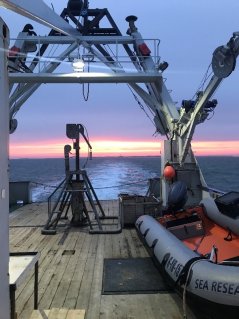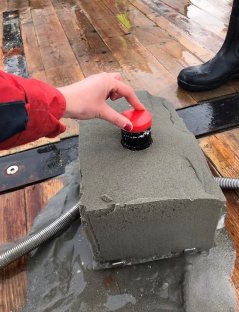
Project
Luminescence as a sediment tracing tool - studying the dispersion of nourished ebb-tidal sands in the Wadden Sea
PhD project Anna-Maartje de Boer as part of the NWO funded TRacking Ameland Living Lab Sediment (TRAILS) project
Problem description
The Dutch deltaic coastline is vulnerable for the repercussions of climate change, such as sea-level rise, salt water intrusion, coastal erosion and/ or barrier island migration. In seeking solutions, coastal management practices focus progressively on the principle of ‘Building with Nature’, thereby implementing an intensive sand nourishment program alongshore. In 2018, for the primary time, an ebb-tidal delta nourishment was carried out: 5 Mm3 of sand has been supplied into the Ameland Inlet between the Wadden Sea islands of Terschelling and Ameland. This unique pilot-study will be researched in our project, called TRAILS – Tracking Ameland Inlet Living Lab Sediment. The TRAILS consortium aims to assess the ecological and societal impact of nourishments on open sandy coasts, building on detailed monitoring from Kustgenese 2.0 and SEAWAD programmes. In understanding system responses, there is an urgent need for suitable sediment tracing methods to monitor and predict nourishment dispersion.
Within my PhD project I will focus on developing luminescence techniques as a novel sediment tracing tool. Luminescence is a well-established method in dating the time of deposition and burial of sand grains. Insufficient luminescence signal resetting (e.g. poor bleaching) resulting in age overestimation is unwished-for in dating sediments. However, it is the main principle of the tracing mechanism: the native beach sediment is expected to be well-bleached in comparison to the poorer bleached nourished sand. Upon transport the nourished sands will be partly light exposed, where the intensity of bleaching strongly depends on the luminescence signal, e.g. fast-to-bleach quartz-OSL or slow-to-bleach TL and/ or (pIR)IR-feldspar signals. We hypothesize that the differential resetting of luminescence signals can give us insight into the end-member (native or nourished sand) and its transport history.


Figure 1: boxcore sampler on deck of the Navicula (NIOZ research vessel) used to retrieve sediment from the seabed (left) and a tube full of sand extracted for luminescence analysis (right)
Objectives
The objectives of this project are:
- Develop a suitable luminescence measurement protocol for differentiating nourished sand grains from native Wadden Sea sand grains based on single-grain feldspar measurements.
- Quantify how the subaqueous spectral distribution in the Ameland Inlet changes over depth as a function of climatological and hydrological conditions. Couple the spectroscopic variations to subaqueous bleaching potential of the slow- and fast-to-bleach luminescence signals.
- Quantify bleaching of native and nourished sands. Trace the spatial dispersion of nourished sands throughout the Ameland Inlet.
- Quantify the role of soil bioturbation on tidal flats in the Wadden Sea. Trace the mixing of nourished and native sands into the soil column.
Project information
Start of the project: September 2020
End of the project: September 2024
This PhD project is part of the NWO-funded TRAILS project, leaded by Prof. Dr. Jakob Wallinga from Wageningen University & Research. Therefore, I closely cooperate with our partners from the TRAILS consortium: Delft University of Technology, Royal Netherlands Institute of Sea Research (NIOZ), Van Hall Larenstein – University of Applied Sciences, Deltares and Rijkswaterstaat.
Please contact me if you wish to receive more information about my project (see contact details above).